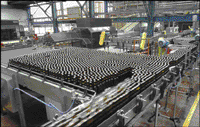
Machine Vision Patent to Go to Trial
Stephanie A. Weiss
A federal judge declined to throw out Jerome H. Lemelson's machine vision patents based on expert opinions, so the Cognex patent lawsuit against the Lemelson Medical, Education and Research Foundation will go to trial.

Users of machine vision technologies must wait another several months, if not years, to learn whether Cognex will prevail in its patent-related lawsuit against the Lemelson Medical, Education and Research Foundation.
US District Judge Philip M. Pro ruled July 12 that only a trial could properly determine whether Lemelson's patents cover modern machine vision and bar-code scanning applications.
On behalf of customers
Lemelson first applied for patents in the 1950s, but then extended them and added ideas for more than 30 years before the Patent and Trademark Office granted them. Lemelson and, after his death, the foundation set up in his name approached machine vision and barcode users for license fees, claiming that they were violating the patents.
Cognex sued the foundation on behalf of its machine vision customers.
Cognex had asked the judge to invalidate the patents without a trial, saying that they do not adequately describe the technology that the foundation claims to own. Specifically, the company argued that at least some of the patents cover only applications in which " 'test' objects [are] scanned in identical locations, at the same fixed distance from, and in the same fixed orientation to, the scanning camera."
As such, Cognex argued, the patents should cover only "prepositioning" applications -- those in which an object has to be placed in a specific location before inspection.
An expert for Lemelson argued that the patents describe some generic application types that would not require specific placement:
- Scaled or relative measurements, in which the inspection system would determine the relative distance between image features.
- Frame-to-frame surveillance methods, which would look for changes between frames, such as an object that appears to be getting larger (moving toward the camera) from one frame to the next.
- Photoelectric scanning, in which an object would move past the camera or the camera past an object.
The judge decided that a trial would best determine whether those applications require prepositioning "and whether persons of ordinary skill in the art would have recognized that the inventor invented what is claimed."
Earlier this year, another federal judge in New York decided that NCR Corp.'s license of the Lemelson patents should cover its customers' use of related equipment.
The judge refused to allow the foundation to rescind NCR's license, which included a covenant in which the foundation agreed not to sue NCR ustomers over the patent.
Published: September 2001